It is simply impossible to imagine a garden or any plot near the house without fruit trees. It is apple trees and pears that are an integral part of the courtyards. However, the plot area is not always possible to plant several such trees, and sometimes one pear is difficult to attach. In this case, pay attention to the colon-shaped varieties of fruit.
Colon's pears are an excellent replacement with familiar trees. They grow not in breadth, but height, that significantly saves the place. Today, a large number of varieties of this culture are derived for breeders, which give abundant harvest of juicy fruits. At the same time, planting and care for colonum pear does not make much difficulty.
In this article, consider the features and description of the colonum-shaped pear, as well as its most popular varieties. We note important nuances of agrotechnics of growing this culture.
Features and description of colonum pear
Colon's pear is a dwarf representative of fruit and decorative garden trees, which refers to a large family of pink and pearfish. This culture is practically no different from its more large relative - ordinary pear. The exception is only the size of the tree and the form of the crown. The territory of Central Asia and the Transcaucasia is considered the territory of Middle Asia and Transcaucasia, where these wonderful fruit trees appeared for the first time. Colon's pear, according to experienced gardeners, has a number of advantages that allow without problems to plant a large number of trees on a small plot of land, while getting a huge crop of juicy fruits.
The word "pear" most likely went from the word "Khrush", which was written in the Belarusian chronicles. That is how this fruit was called in ancient times. This is most likely with the crunch of juicy pear pulp during the bite.
This type of pear was brought for the first time as a domestic breeder Kacchalkin and since then enjoy great popularity.
Colonial pear description:
- Colon's pears are dwarf falling fruit trees, which in their peculiarities do not differ much from ordinary pears.
- As much as possible, the colon-shaped pear reaches 2.5 m, while ordinary pear can grow by 4-5 meters. The average height of colonum pear in the garden can be about 1.5 meters.
- The trunk of colonum pear is thicker.
- The dwarf tree of colonum pear is very compact and occupies little place on the plot.
- The branches do not greatly grow, they are located along the trunk and with a large rustling you can cut them. In appearance, such pears resemble a high column.
- The leaves are quite large, wide, dark green with a glossy surface. Can grow directly on the trunk and shields shielded to it.
- In the spring, fragrant white flowers collected in umbrella inflorescences appear on this dwarf trees.
- The fruits ripen on small branches, which is thickly suiced the whole trunk.
- Fruits from colon-shaped pear larger size than the usual. The weight of one fetus can reach 400 grams (at the summer variety).
- Fruits are also distinguished by juice and great yield.
Advantages and disadvantages of colonum pear
Many gardeners still do not know what the feature of this culture, how to plant colon-shaped pears, as they care for them. Features of planting and care practically do not differ from the usual pear, but in turn, a colonum-shaped pear has its advantages and small flaws.
Advantages of colonum pear:
- Tree compactness, which allows you to take less space.
- High yield. From one tree you can collect on average from 3 to 8 kg of pears.
- Fast period of fruiting. A colonum pear begins to give a harvest for the second year after vaccination.
- Quite large size of fruits and their juiciness.
- Colonum-shaped pear seedlings are good on any plot with different soils.
- Most varieties of colonum pear have resistance to diseases and pests.
- Do not require special care.
- Sustainable frost.
Disadvantages of colonum pear:
- Since a colonum-shaped pear is a decorative plant, you must regularly monitor the crown of these trees.
- In such dwarf fruit trees a very short period of fruiting - only 10 years.
- The life of colon-shaped pears is also small.
- To date, there are still not many varieties of this culture.
Varietal variety of colonum pear
Today, colonum-shaped pear varieties are not so much, however, breeders work hard to increase the number of species of this dwarf fruit tree. All available varieties can be divided into early, late-seated, autumn, winter, summer-autumn. Each of these varietal groups have its own characteristics, the volume of crop, the size of fruits and their taste. We give an example of a description of varieties of colonum pears, which were popular among gardeners.
Pear coloniff "sapphire"
- Pear of this variety begins to be fruit for 3 years after vaccination.
- Full ripening of fruit occurs in September. It is during this period that the harvest can be collected.
- The fruits of such a variety of colonum pear differ in large sizes. The weight of one pear can reach 200-250 grams.
- In the form, the fruit slightly elongated, differs in greenish-pink shades.
- The fruits do not endure frosts, so they are stored in the basement or in another cold place will not be.
- To taste, sweet and juicy fruits.
- It is a fairly winter grade.
- From the fruits of colonum pear sapphire, you can prepare jam, jams and confitures.
Pear Colon's "Carmen"
- It is a dessert variety of colonum pear.
- Due to its compact form and beautiful appearance during flowering and fruiting, it can be grown as a decorative element.
- This variety of pears is a bright coloring of fruits - red-burgundy.
- Fruit with rather large fruits, the weight of one can be approximately 200-250 grams.
- To taste the fruits of this grade juicy, sour-sweet.
- Fruit begins for the second year and is distinguished by quite high yield.
Pear Colon's "Tenderness"
- This variety of colonum pear is autumn.
- The fruits of the medium size, the weight of one is approximately 150-200 grams.
- Differs on the fruits of the egg-shaped form of a saturated yellowish-green color.
- To taste the fruits of juicy and with small sourness.
- This variety is characterized by a good yield, the fruits can be collected in September.
- Fruit colon-shaped pear tenderness starts only for 5 years.
Pear coloniff "Decor"
- Colon's pear of this variety reaches 2 meters in height.
- Fruit starts for the second year.
- Differs good yield and endurance, rarely amazed by various diseases.
- Fruits at variety are large, the weight of one reaches 200 grams.
- The form of the fetus is pear-like, in the color of yellow-green.
- The fruit of this variety is juicy, sweet with sour and white flesh.
- You can collect harvest already at the end of August.
Pear Colon Featory "Honey"
- Pear Colon-shaped honey is a summer variety, fruits ripen already in August, when they can be massively assembled.
- The fruits of this grade of yellow-green color with an orange barrel.
- Form fruits slightly oblong oval.
- Different variety of good yield and very large sizes of fruits. The weight of one fetus can reach 400 grams.
- Pears of this tree are very fragrant, the pleasant smell of which is preserved for a long time.
- To taste the fruits of juicy and sweet.
- Enough frost-resistant grade, grows well on any soils.
Pear Colon's "Nay-vert"
- Fruit this variety of colonum pear begins for the second year after landing.
- The yield of the variety is good, the fruits ripen large. The weight of one can reach 200-250 grams.
- Fruits with pink sideways, very tasty and sweet.
- This variety of dwarf trees does not tolerate strong frosts.
Pear coloniff "Sanremia"
- This variety is distinguished by high yield and unpretentious to the landing site.
- It has a sufficiently high frost resistance.
- It is a late-year-old variety, the crop can be collected in October or November.
- Fruits are distinguished by very large sizes, the weight of one can be almost 400 grams.
- To taste the fruits are very sweet and juicy, gentle with the aroma.
Pear Colon Featory "Northerkhan"
- This variety of colonum pear is characterized by rapid growth and earlier ripening of fruits.
- Vintage can be collected at the end of July or early August.
- The fruits of this variety of medium sized, yellow-green with pinkish spots and streaks.
- To taste juicy and sweet.
- If you remove from the trees already matured fruits, you can keep them no more than two weeks. If we rip pears to their full ripening, then the shelf life can be increased to 1.5-2 months.
In addition to the above, you can note the pear Colon's delight, Pavlovskaya, the favorite Yakovlev.
Best varieties of colonum pear for Moscow region
- Grade "Tenderness".
- Sapphire grade.
- Sort "Northerkhan".
- Grade "Firefly".
- Grade "Decor".
- Sort "Carmen".
Colon's reproduction pears: the most common ways
Specialists recommend buying a coloniform pear so that in the end it is planted on its site. The reproduction of this culture is seminently given very difficult. First, it takes a lot of time and work. To obtain a fruiting colonum-shaped tree, pear will be held more than one year. In addition, in this way you can get not all varieties of colonum pear.
The reproduction of colon-shaped pears vaccine
Colon's pears can be two species: seed and graft. Seed pears are bred by naturally, due to natural genes. By vaccinating, you can instill saplings of a dwarf pear on such inserts like Quince or Irga. Binding is best done at the end of April or in early May. Choose better morning or evening, or within the course of the day, if the weather is cloudy. Cuttings for vaccinations are recommended to harvest in winter, and when carrying out the vaccination process, use only clean and sharp tools in order not to make unnecessary movements.
- You can vaccinate a colonum pear in several ways: for the bark, in the side section and in the splitting.
- For the vaccination, the cuttings of the wire 70-80 cm long, which are harvested in winter and stored in a cool place.
- Before the process on the selected stock, for colonum-like pears is quince, all fruit branches are cut off, leaving only 40 cm of their length.
- After that, the cuttings of the colonum pear are vaccinated.
- At the same time, the place of vaccination is covered tightly tightly and lubricated the garden Wara.
- Typically, the period of survival is approximately 3-4 weeks.
Colon's breeding pear breeding
- To reproduce the clone pear in this way it is necessary to prepare green cuttings in advance.
- The length of each cutter should be approximately 25-30 cm and each must contain at least five leaves and two interstices.
- In a separate container, divert a special solution of the rootwork, often used corpering. Place the cuttings cleaned from the bottom for a couple of days in this solution. This stimulates faster rooting of colonum-shaped pear.
- After completing this process, the cuttings are cheered into the soil mixed with a small part of the sphagnum.
- Usually, when all the conditions of this method of reproduction, the rooting of the cuttings occurs quite quickly.
Preparatory work before landing colonum pear
The crongal pear is still considered an unusual guest in garden sites, so before planting this culture it is important to carefully prepare. It is importantly important to choose the saplings of a dwarf pear and decide on the landing site. Only with a competent and serious approach to the preparatory stage you will have to grow a healthy and fruiting tree of colonum-shaped pear.
Stage 1. Selection of seedlings and varieties of colonum-shaped pear
- The choice of healthy seedlings is one of the most important steps, so it is necessary to approach this issue with a special seriousness.
- First of all, it is necessary to acquire seedlings of colonum-shaped pear in nurseries. To do this, find special garden centers and kennels in our settlement, which are engaged in breeding plants. Only here you can get healthy and strong seedlings that are already adapted to the climatic conditions of your area.
- In the nursery you can get a professional advice on the right landing and care for a seedling of a colonum-shaped pear.
- Acquire best annual seedlings that are faster and better leaving and less susceptible to diseases.
- Before buying, too carefully inspect the entire plant. If you get in the nursery, the seedling for you dig in your eyes. Carefully check the root system, it should be healthy without rotting dry parts.
- The satellite barrel should also be clean and neat, it should not be visible signs of diseases and pests.
- Buy the best seedlings of a colonum-shaped pear of those varieties that are suitable for your climatic zone. For the Moscow region, Northerkhan, tenderness, Carmen are ideal. And for warmer areas, it is possible to purchase Nay-vert, Sanremia.
Stage 2. Choosing a place to land a colonum pear
- Colon's pears do not distinguish special advocacy to the landing site.
- An important condition - the landing of a colonum pear should be held in a place protected from wind and draft. Since the tree itself does not differ in large size and in young age may be damaged during severe gusts.
- A place to land this culture can be chosen even the most secluded and remote. For one tree, it is enough to use 50-60 cm plot of land.
- Some varieties of colonum pear are used as decorative elements of landscape design, so seedlings can be planted on the site near the house.
Stage 3. Choice and preparation of the soil for landing colonum pear
- To the soils, the colon-shaped pear is also not demanding, can even grow on lime.
- However, for better survival and getting a good harvest in the future, the soil must be well fertilized.
- Specialists recommend landing seedlings of colonum pear in spring, so the soil preparation is best to do in the fall. To do this, the selected area is carefully unpacked, about 2 bayonet shovels. At the same time, you can add a bit of humus. The main part of the humor is added during the landing.
- After that, the soil is well fried and leveling.
TECHNOLOGY OF PLAYING OF COLON RIG
- If you do not know how to put a coloniform pear, then you will try to describe the whole planting process as you can describe.
- The best time for planting colonum-shaped pear seedlings is spring, so your tree will have time to grasp the onset of cold.
- A couple of days before the landing, prepare landing pits.
- It is important not only to dig the pits, but it is necessary to determine the distance between several seedlings. It will be optimal between the colon-shaped pear seedlings to observe a distance of 50 cm, and between the rows of approximately 100-150 cm. Thus, you will provide seedlings the optimal influx of fresh air and sunlight. And this is the pledge of the health of your trees.
- The size of the landing pit should be quite large, about 80 cm deep and 60 cm wide. Focus on your seedlings and their root system in collected form.
- Prepare pits. For this purpose, approximately 8-10 liters of water must be added. Wait until the water is absorbed and add 4-3 buckets of humidification, mixed with sand in a ratio of 2 to 1 to each landing well.
- Mix with superphosphate and potassium sulfate.
- Next prepare seedlings. It is important that the root seedlings system will be pulled out in water. To do this, they can be lowered into a capacity with water for a while.
- At the bottom of the landing pit, put on the third part of the soil, then place the seedling on this layer and gently straighten the roots.
- From above, pour the remaining soil and compact the surface with your hands.
- Update every seedling with water, for amenities you can make around the plants of the wells.
- Immediately put the support for colonum pear.
Planting a colonum pear - video
Agrotechnical cultivation of colonum pear
Colon's pears need constant and attentive care, just so you can get a large harvest of juicy fruits.
Watering a colonum pear
Without regular irrigation, you are unlikely to get a good harvest. Therefore, it is very important to monitor the state of the soil surface and develop a specific watering mode. With enough cool weather, colon-shaped pears need to be about once every 3 days. If the street is hot weather, the amount of irrigation increases to daily. For the right watering in the rolling circle, make a small recess and water directly there. So you will provide normal saturation of the root.
Swimming and mulching of colonum-shaped pear
Periodically, the soil around the seedlings need to loosen, but do it very carefully. The root system of young trees is located close to the surface and you can damage it. It is recommended to remove all weeds growing around a colonum pear. To prevent the appearance of a large number of weeds and to reduce the amount of loosening, the propeller circle can be inspired by straw or sawdust.
Fingering colonum pear
For full growth and fruiting with colon's pears, feeding and regular spraying are important. With the help of spraying, you can protect trees from harmful microorganisms and various pests. For this process, you can use copper vigorous, iron vigor.
The feeders are held three times in the spring and summer period:
- The first feeding should be carried out immediately after the appearance of the first leaves on the tree. As a fertilizer, you can use urea or chicken litter. Run 10 grams of urea in 2 liters of water. This norm is enough for one tree.
- The second feeding is carried out 2 weeks after the first.
- Third feeding - 4 weeks after the last.
Obr.oge of colonum pear
How to trim a colonum pear go another fruit tree should know every gardener.
- Some colonum-shaped pear seedlings can get blossom in the first year. In this case, all the flowers need to be removed so that the tree is all the forces sent to root.
- The following year, when the colors appear, it is recommended to leave a maximum of 2 flower.
- In order for the culture to grow and fruit, spend the trimming on time. A young seedlings need to shorten shoots, leaving two kidneys.
- Often trimmed branches are not recommended, otherwise they will begin to grow very quickly.
- In the spring before the start of the Software, cut all the side shoots that began to grow aside, leaving for 2 kidneys.
- If the top kidney is damaged, additional branches begin to grow out of it. In this case, you need to leave one, and the rest delete.
- After trimming the location of the cut, we treat the garden boraner.
Preparation of colonum pear to winter
In the fall, when all the foliage falls, you need to start training seedlings by winter. Initially, remove the whole garbage around the trees, otherwise pests may start there. If your seedling is not three years old, it is better to cover together with the top kidney, since at this time it is especially sensitive. For shelter use burlap.
It is also important to protect the root system. To do this, cover the rolling circle of sawdust, straw and spruce legs. To prevent damage to the trunk of the tree with hare and mice, it is covered with rubberoid and spruce legs.
Fighting diseases and pests of colonum pear
It is much easier to protect your trees from pests and diseases than then heal them. For this, it is important to break the trunks of trees every year, spray them. You can also plant about seedlings of plants that scare the pests. This is Melissa, tobacco.
Diseases:
- Scab. This disease is manifested by stains throughout the plant and quickly applies. To combat it, it is necessary to remove the fallen foliage and burn it, spray all the tree in the spring urea.
- Puffy dew. If your colon-shaped pears got sick of this disease, they fall off the wounds, flowers and fruits. It is important to trim the affected shoots and use special insecticides to combat the disease.
- Rust. With such a disease, foliage suffers and fruit. It is important to eliminate all infected areas and process all the wood with gray.
Pests:
- TLL, Pear Median, Pear Tick. To combat such pests, use special preparations - insecticides.
Colon's Pear - Photo
Colon's pear is an excellent solution for gardeners, which are limited in space on the plot. They do not occupy a lot of space, but they give a large harvest of delicious and juicy fruits.

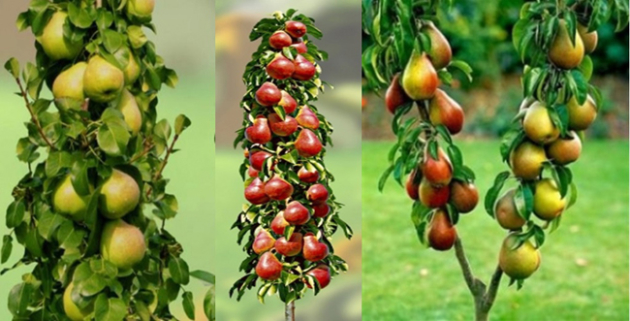
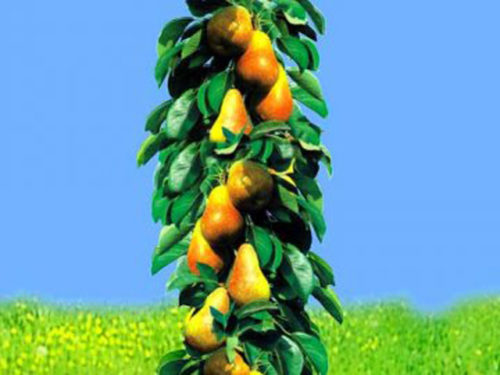
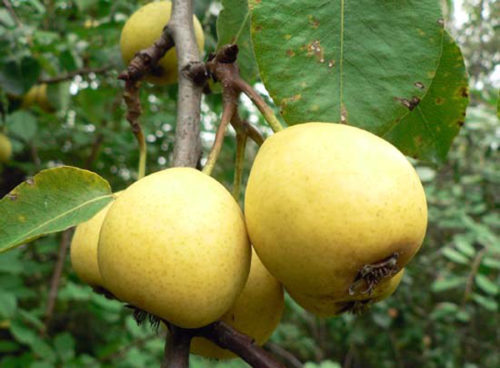
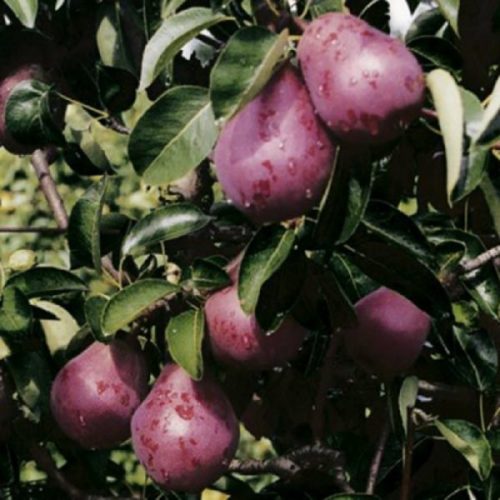
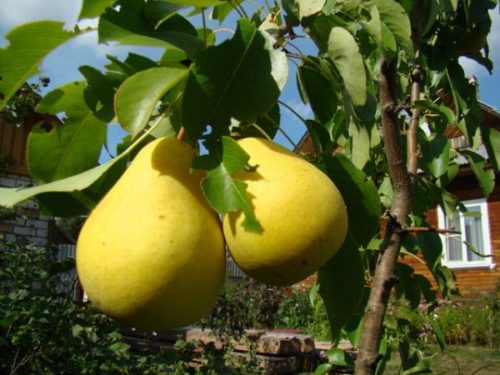
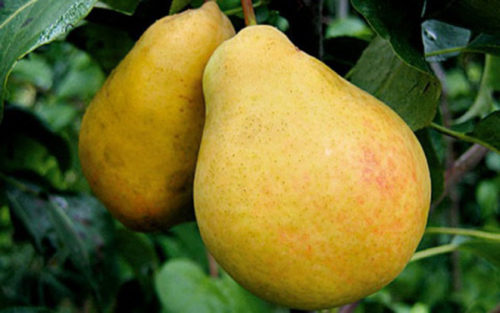
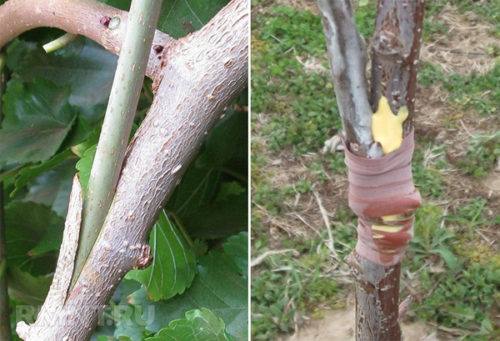
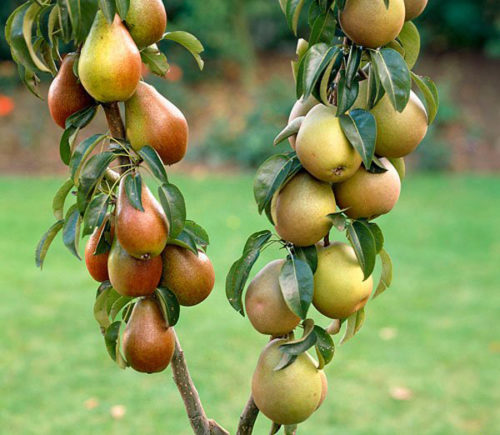
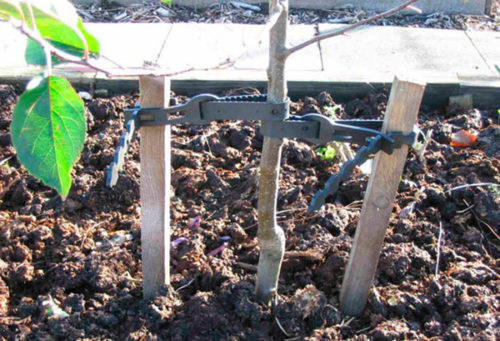
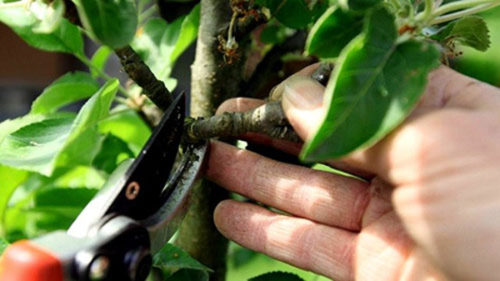
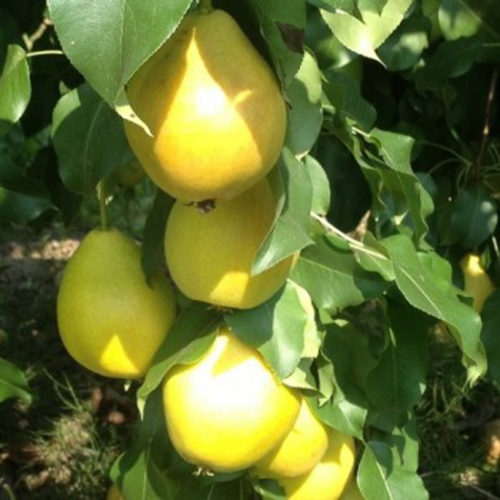
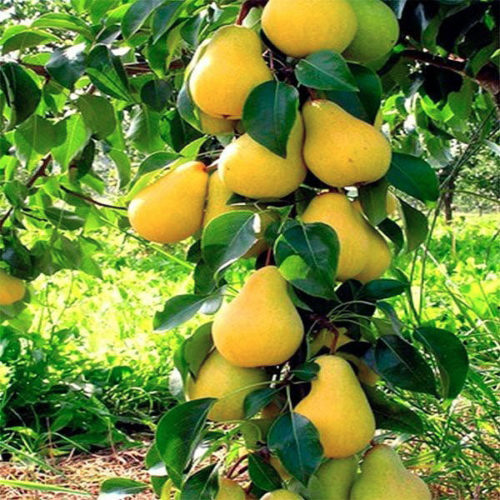
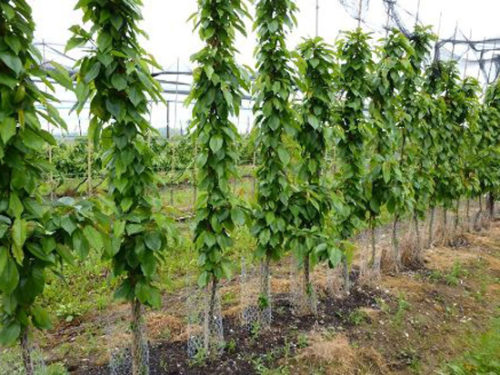
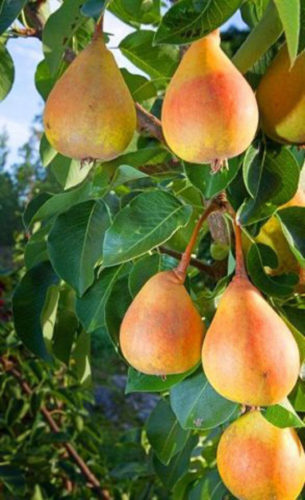












 Start a discussion ...
Start a discussion ...